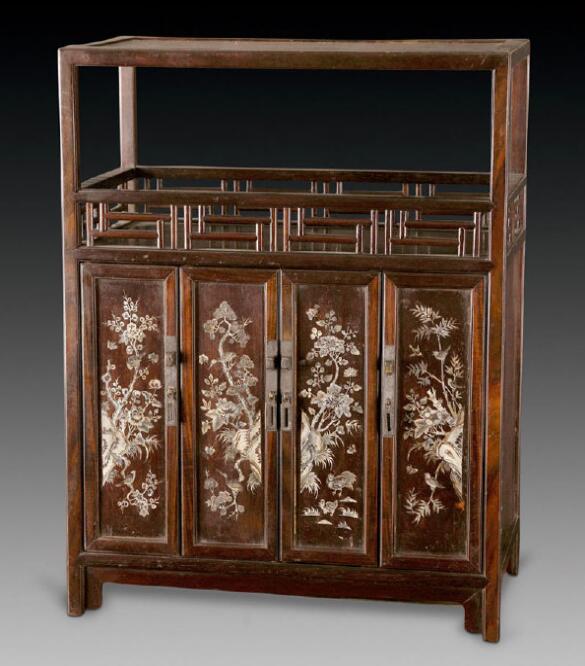萬物變遷,滄海桑田,美麗奇幻、紋理多變的貝殼,作為大自然的產物,與人類結下了萬年之緣。 早在五萬年前山頂洞人時期,貝殼就被穿成貝鏈作為裝飾。 中國的商代到秦代,貝類被打磨穿孔后,長期當作貨幣使用。 秦漢時期,貝殼被雕出簡單的鳥獸紋圖樣,鑲嵌在銅器、鏡子、屏風和桌椅上作裝飾,俗稱“螺钿”,這種工藝目前不少地區仍然保留著。
A包養網 花園s a product of mother nature, the beautiful and magical time-honored shells with varied textures have shared a bond with human beings for thousands of years.Shells were worn in 包養網chains by cavemen as far back as about 50,000 years ago. From the Shang Dynasty (about BC 1600) to the Qin Dynasty (about BC 207)in China, she包養網lls were used as money for a long time after being polished and perforated. During the Qin and Han dynasties (BC 221-220), shells were carved with simple patterns of birds and animals and inlaid on bronze vessels, mirrors, screens, tables and chairs for decoration. Commonly known as “mother-of-pearl”, the craft is still preserved in many regions today.

第44屆世界遺產大會在福建福州舉辦,平潭被列為世界遺產大會的參觀點之一。 平潭是福建省東部沿海一個島縣,為全省第一大島、中國第五大島。 平潭貝雕作為省級非遺專案亮相世界舞臺,利用貝殼的天然色澤、紋理、形狀,經過藝術構思、磨雕、粘貼,成為工藝品。
During the 44th session of the World Heritage Committee held in Fuzhou, which is the capital city of Fujian Province, Pingtan was listed as one of the visiting spots of the event. As an island county in the east coast of Fujian, Pingtan is the largest island in the province and the fifth largest island in China. P包養ingtan shell carving, as a provincial intangible cultural heritage project, shined on the global stage. Using the natural color, texture and shape of shells, Pingtan shell carving has turned shells into artifacts after artistic design and craftmanship.

這份美麗首先來源於自然的饋贈。 平潭盛產貝、螺、蚌、蛤等海產品,形態各異、色彩斑斕。 平潭貝雕在繼承傳統工藝的基礎上,吸收玉雕、木雕和國畫等眾家之長,結合螺鈿鑲嵌工藝特點,於1955年成功創製了浮雕形式的貝雕畫和多種實用工藝品,從而揭開了貝雕工藝史嶄新的一頁。 平潭貝雕以立體、小巧、實用為主要特色,創造了貝殼堆畫、立體圓雕、嵌貝漆器、嵌貝盒子和貝雕花插等5大類200多個品種。
The shell carving’s beauty is a gift of nature. Pingtan is rich in shellfish, conches, clams and other seafood with different shapes and colors. Building on traditional crafts, Pingtan shell carving also picked up ski包養網lls of jade carving, wood carving and traditional Chinese painting. Combining with the features of mother-of-pearl inlay, Pingtan craftsmen created shell carving paintings in relief form and various practical handicrafts in 1955, thus opening a new page in the history of shell carving. Known for its three-dimensional, small and practical features, Pingtan shell carving has more than 200 varieties in five categories, such as shell stacking painting, three-dimensional round carving, shell-inlaid lacquerware, shell-inlaid box and shell carving flower receptacle.

不同貝殼擁有不同的色澤和形狀特點,平潭老藝人對它們有著巧妙的運用:帶斑痕的貝殼,可鋸成唯妙唯肖的樹木軀幹; 帶螺絲旋紋的貝殼,切成如雲般的仕女發髻…… 既有刻畫人物和動物形象的,又有描繪花草和山水的,多姿多彩、惟妙惟肖。
Different shells have different colors and shapes, and Pingtan veteran craftsmen have clever use of them: spotted shells can be made into lifelike tree trunks; Shells with screw lines are cut into ladies’ bun… Colorful and vivid depictions of characters and animals, flowers and landscapes could be made from shells.

平潭貝雕代表著海洋文化與中原文化的碰撞,巧妙地將人與海結合起來,具有貝殼的自然美、雕塑的技法美和國畫的構圖美與格調美。 同樣是貝雕,不同的文化背景下風格卻截然不同,德國、義大利等西方貝雕多以浮雕首飾為主,色彩單純,帶著宗教、偶像崇拜及紀念的烙印。
Pingtan shell carving represents the fusion between marine culture and Chinese culture. The art skillfully combines mankind with the sea, featuring the natural beauty of shells, the beauty of sculpture techniques and the beauty of composition and style of traditional Chinese painting. Shell carvings can have quite different styles under different cultural backgrounds. Western shell carvings in countries such as Germany and Italy are mainly embossed jewelry, with simple colors and religious, idolatry and commemorative elements.
如今隨著中外文化的交流和互通,越來越多的人關注並加入貝雕技藝的傳承與保護中來,這把“藝術薪火”又被重新點燃和燒旺。
With the exchange and intercommunication of Chinese and foreign cultures, shell carving is gaining growing attention and participation in its inheritance and protection. The time-honored art is enjoying a new breath of life.
標籤: [db:标签]